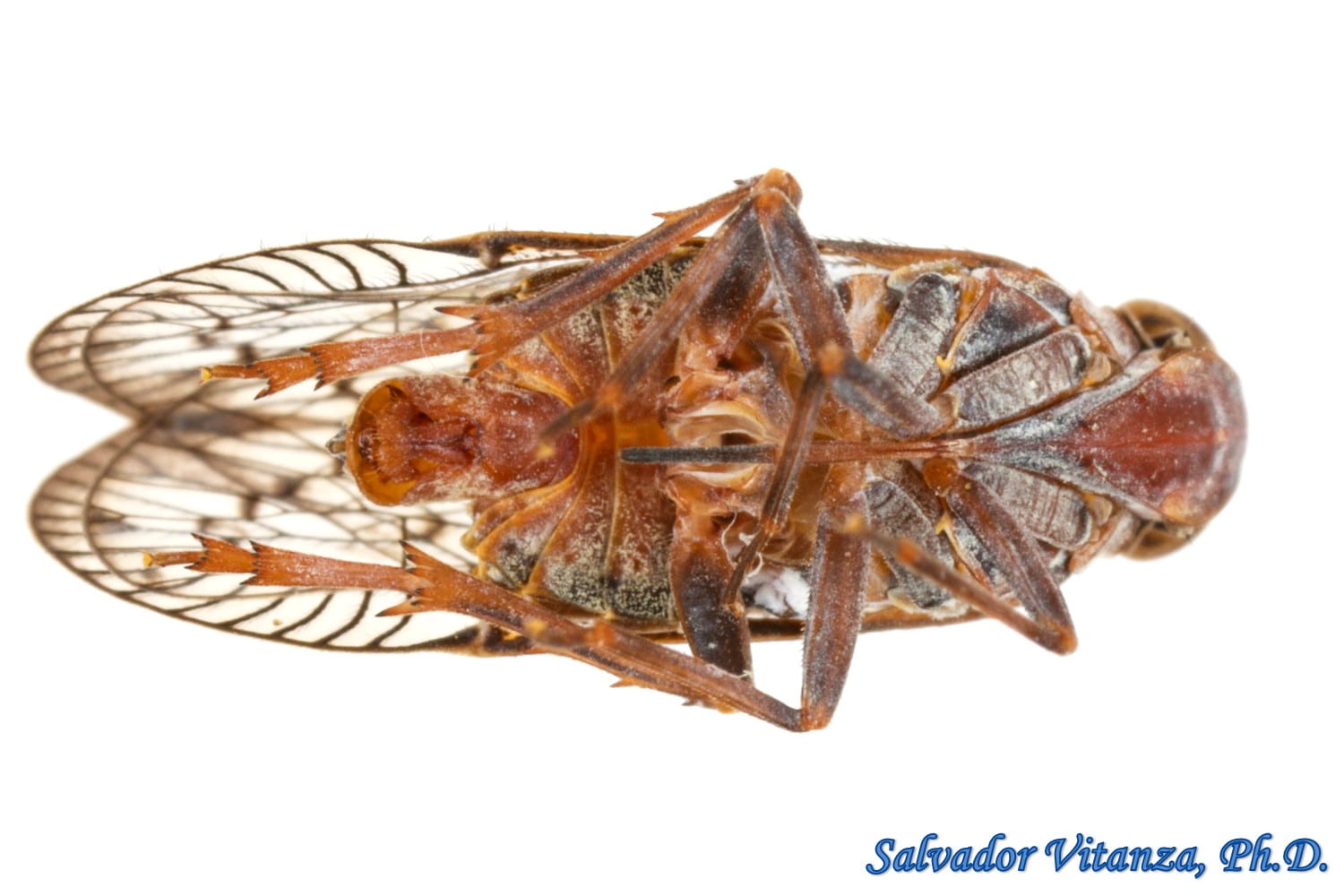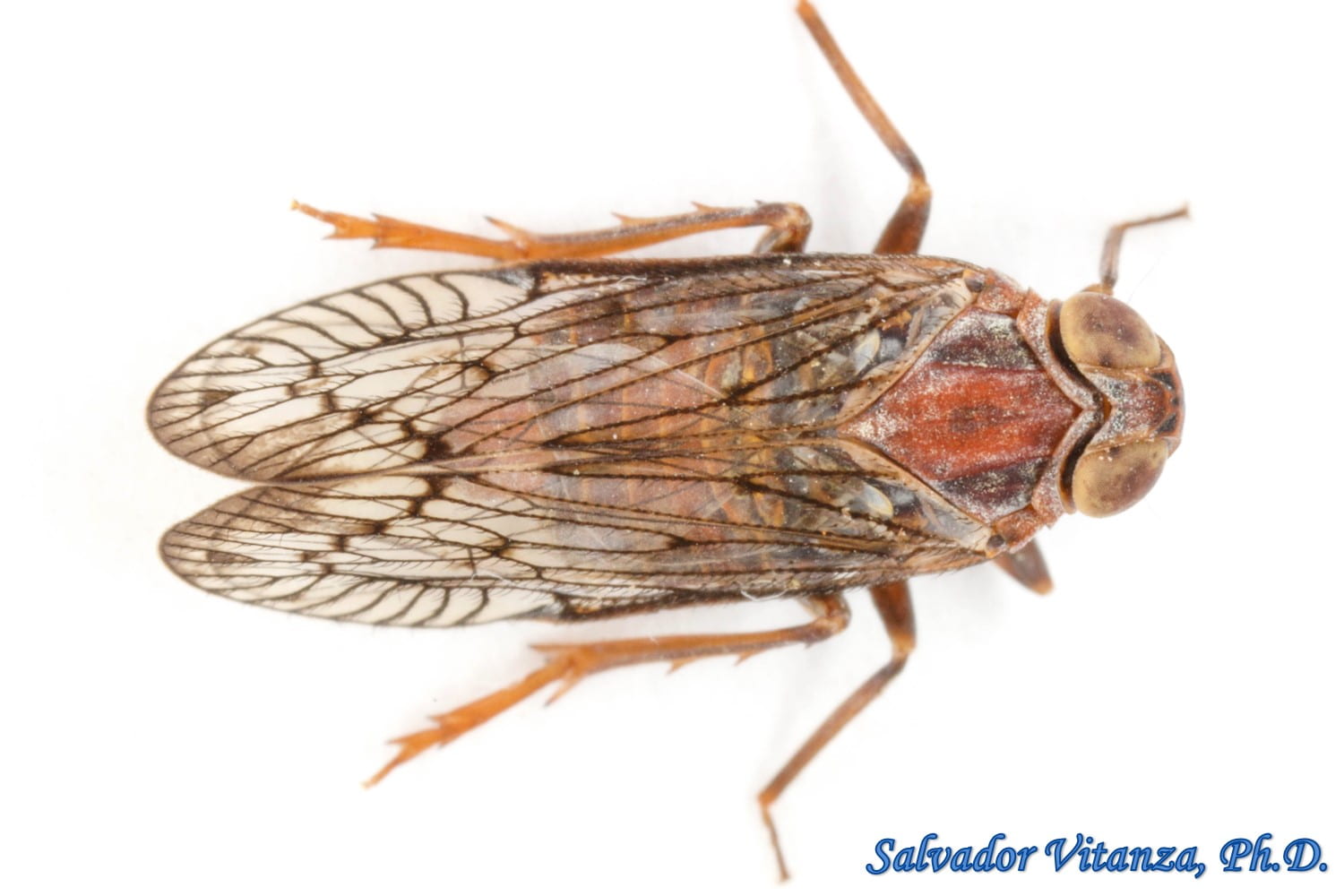[Back to North American Cixiidae]
Family Cixiidae Spinola, 1839
Subfamily Cixiinae Spinola, 1839
Tribe Pentastirini Emeljanov, 1971
Genus: Oliaronus Ball, 1934
Type species: Oliaronus tontonus Ball, 1934.
Synonyms: None.
Distribution
USA: Arizona.
Recognized species
There is a single species in this genus.
Oliaronus tontonus Ball, 1934 – USA: AZ.
Economic Importance
Limited, infrequently encountered.
Plant associations
Oliaronus tontonus – Prosopis (mesquite, Fabaceae).
Not even on FLOW.
Recognition
With lateral spines on hind tibiae, mesonotum with 5 carinae, posterior margin of vertex angularly incised, the middle portion of costal area of each forewing thickened, dark, and setaceous.
Description from Ball (1934), verbatum (from Archive.com):
Oliaronus Ball n. gen.
Intermediate in size and form between Mnemosyne and Oliarus. Resembling a large dark Oliarus with an extremely broad head and long, narrow, almost parallel margined elytra. Vertex very broad, but little longer than broad, almost parallel margined, the lateral carinae angled just in front of the middle and uniting before the apex, forming two large fovae. Front tumid, rounding over to vertex with only a trace of a carina, broad at the base and narrowly clasping the extremely long, oval, tumid clypeus. The ocellus visible and a median carina on front and clypeus indicated. Prono- tum as short or shorter than in Oliarus, deeply angularly emarginate posteriorly and projecting into the angularly emarginate head. Mesonotum faintly 5 carinate. Elytra long and narrow with a smoky subhyaline membrane and strong dark nervures that are heavily setigerous throughout. Ve- nation striking and distinctive. The subcosta (+R) approaching the costa which is thickened back to the stigma and the whole thickened area thickly beset with heavy setigerous punctures. The area between the subcosta and medius with scattering punctures in the central part. The stigma located anterior to the end of the clavus, the subcosta and radius both turning in, the subcosta capturing the radius about half way back from the stigma and thus forming a very broad area along the costa, which is divided into from 8 to 10 long narrow transverse cells. The female abdomen with a large wax plate.
Type of the genus Oliaronus tontonus n. sp.
Oliaronus tontonus Ball n. sp.
Superficially resembling Oliarus pima Kirk, slightly longer and narrower, much darker and more heavily setigerous; with a series of transverse vein-lets back of the stigma. Length 9 10 mm, cf 8 mm, width 9 3.5 mm.
Structure of the genus, the vertex almost square, rounding over in front, face much narrower than in O. pima and more tumid. Pronotum very short, not more than half the length of that in pima, the carina closely margining the eyes. Elytra long, narrow, and appressed, the apical third slightly expanded, the costal margin with a slight angle near the base, the costal area back of this very narrow, darkened and heavily pustulate. The stigma very short and placed far forward, only a little farther from the base than the apex. Behind this in the expanded area are 8-10 long narrow transverse cells becoming more oblique as they approach the apex. Color, dark smoky brown, the face, margins of vertex and often the mesonotal tablet testaceous; elytra smoky, the nervures black.
Holotype [female], allotype [male], and 10 paratypes Eloy, Ariz., Aug. 5, 1932, one Cline, Ariz. Aug. 2, 1929, all taken from mesquite by the writer; one paratype, Florence July 25, 1932 (Parker). The transverse cells in the expanded margins of the elytra will at once distinguish the species.

Oliaronus tontonus (Salvador Vitanza, Nogales, Santa Cruz County, Arizona, 31.335333, -110.937993, Elevation: 3,932 ft, June 19, 2017, Attracted to mercury vapor and ultraviolet light)

Oliaronus tontonus (Salvador Vitanza – on bugguide, Nogales, Santa Cruz County, Arizona, 31.335333, -110.937993, Elevation: 3,932 ft, June 19, 2017, Attracted to mercury vapor and ultraviolet light)

Oliaronus tontonus (Salvador Vitanza, Nogales, Santa Cruz County, Arizona, 31.335333, -110.937993, Elevation: 3,932 ft, June 19, 2017, Attracted to mercury vapor and ultraviolet light)

Oliaronus tontonus (Salvador Vitanza, Nogales, Santa Cruz County, Arizona, 31.335333, -110.937993, Elevation: 3,932 ft, June 19, 2017, Attracted to mercury vapor and ultraviolet light)
Online resources
EOL.
FLOW.
Bugguide.
Discover Life.
3I Interactive Keys and Taxonomic Databases (Dmitry Dmitriev)
Extension education in El Paso County (Salvador Vitanza)
Arizona State (not sure link will work, to ASU flickr album)
Collecting
Attracted to lights!
Molecular resources
As of this writing, there are no molecular data for this genus on Barcode of Life or Genbank.
Selected references
Ball, E. D. 1934. The genus Oliarus and its allies in North America (Homoptera: Fulgoridae). Journal of the Washington Academy of Science 24: 268-276.
Bartlett, C. R., L. B. O’Brien and S. W. Wilson. 2014. A review of the planthoppers (Hemiptera: Fulgoroidea) of the United States. Memoirs of the American Entomological Society 50: 1-287.
Emeljanov, A. F. 1971. New genera of leafhoppers of the families Cixiidae and Issidae (Homoptera, Auchenorrhyncha) in the USSR. Entomologicheskoe Obozrenie 50: 619-627.
Emeljanov, A. F. 2001. The generic position of some Nearctic Pentastirini (Homoptera: Fulgoroidea: Cixiidae). Zoosystematica Rossica 9: 122.
Holzinger, W. E., A. F. Emeljanov and I. Kammerlander. 2002. The family Cixiidae Spinola, 1839 (Hemiptera: Fulgoromorpha) – a Review. Denisia 4: 113-138. [systematics of genus].
Kramer, J. P. 1983. Taxonomic study of the planthopper family Cixiidae in the United States (Homoptera: Fulgoroidea). Transactions of the American Entomological Society 109: 1-57.
Metcalf, Z. P. 1936. General Catalogue of the Homoptera. Fascicle IV Fulgoroidea . Part 2 Cixiidae. Smith College, Northhampton, Massachusetts.
Spinola, M. 1839a. Essai sur les Fulgorelles, sous-tribu de la tribu des Cicadaires, ordre des Rhyngotes. Annales de la Société Entomologique de France 8: 133-337.
Wilson, S. W., C. Mitter, R. F. Denno and M. R. Wilson. 1994. Evolutionary patterns of host plant use by delphacid planthoppers and their relatives. In: R. F. Denno and T. J. Perfect, (eds.). Planthoppers: Their Ecology and Management. Chapman and Hall, New York. Pp. 7-45 & Appendix.


